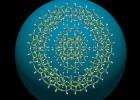(PhysOrg.com) -- Scientists at the University of Glasgow have imaged the self-assembly of nano-particles, unveiling the blueprint for building designer molecular machines atom-by-atom.
Working out how nano-particles are built is key to developing new ‘intelligent materials’, electronic devices, and understanding the bio-machinery that operates in living cells.
The ability to control this self-assembly has profound consequences for the development of new technologies as well as understanding the basis for complex chemistry, and for example, the origins of life.
In a study reported in the journal Science this week, researchers at Glasgow, along with colleagues at the University of Bielefeld, Germany, devised an experiment which enabled them to observe molecules being constructed around what appeared to be a transient template cluster.
The experiment involved the construction a flow reactor system for the assembly of the nano-particles under dynamic ‘flowing’ conditions. This new experimental approach allows self-assembly to be examined in a new way at the nano-level, giving rise to unprecedented mechanistic information unmasking the complexities of molecular self-assembly.
Self-assembly describes the process by which objects form a particular arrangement without any external manipulation.
During the experiment, the researchers observed the self-assembly of molybdenum oxide wheel molecules around an intermediate structure in the centre of the wheel which they found to be the ‘template’ or scaffold used to construct the larger molecule. Following completion of the molybdenum oxide wheel molecule, which is just 3.6 nanometres in diameter, the template was ejected, freeing it to repeat the process.
The researchers were able to ‘photograph’ this process and the template using X-ray crystallography.
Professor Leroy Cronin, Gardiner Chair of Chemistry, Department of Chemistry, who devised and led the study, said: “This advance is very important since in the construction of molecular nano-objects we must rely on ‘self-assembly’ where the nano-scale objects builds itself - a process which is almost impossible to understand or control using current step-wise chemical synthesis approaches
“Therefore, understanding the assembly process is vital if we are to create a new range of functional nano-objects.
“This discovery could lead the way for the designed assembly of a whole range of precisely-defined nano-particles with applications in electronics, medicine, and catalysis to allow the design of intelligent or smart nano-sensors and nano-functional machines, not to mention the fundamental implications regarding the assembly of complex chemical systems, the most spectacular example of which are living cells.”
The idea of ‘molecular machines’, was popularised by US engineer Eric Drexler from the 1970s and involves controlling the positions of molecules in chemical reactions to obtain the desired result.
While scientists can already synthesise many substances and materials in chemistry through the interactions of different compounds, at the nanoscale the task becomes almost impossible because it becomes harder to control.
Cronin added: “This result is massively interesting, not only do we get to ‘image’ self-assembly for the first time using this type of flow system, this discovery will allow us to devise new types of blueprint that could allow the assembly of a whole new class of designer nano-particles opening a whole new world of discoveries and applications.
“This approach will also give information about the fidelity of self-assembly which is of great topical interest especially related to the health impacts of nano-particles in our environment”.
The paper, entitled: ‘Unveiling the Transient Template in the Self-Assembly of a Molecular Oxide Nanowheel’ is the cover story in the latest edition of the journal Science.
Provided by University of Glasgow




















